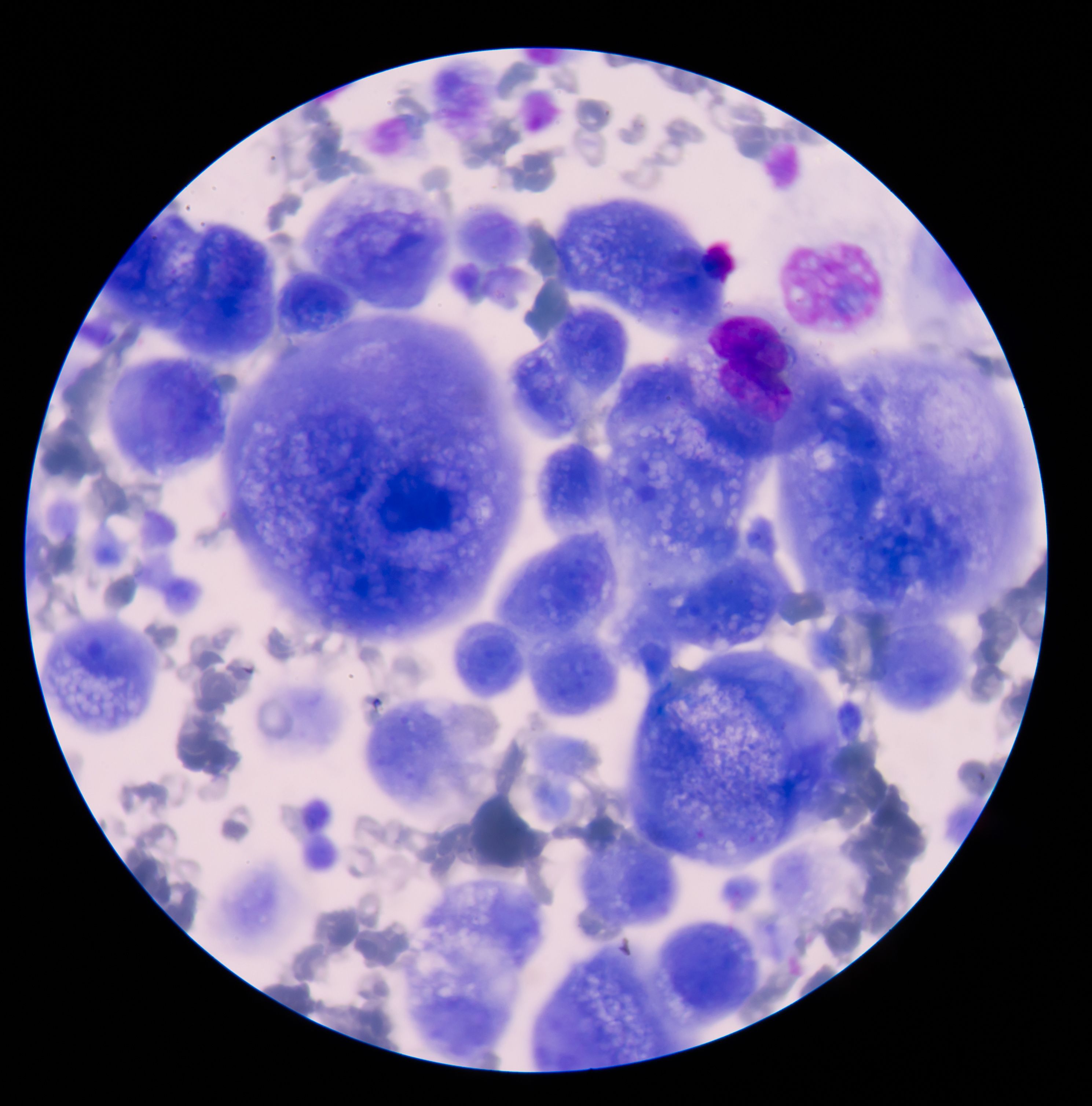Polatuzumab Vedotin Plus R-mini-CHOP Does not Increase High-Grade AEs in DLBCL
Replacing vincristine with polatuzumab vedotin in R-mini-CHOP, although it hasn’t increased grade 3/4 hematologic toxicity, may increase gastrointestinal adverse effects in a cohort of frail patients with diffuse large B-cell lymphoma.
Substituting vincristine with polatuzumab vedotin (Polivy) in a reduced-dose regimen of rituximab (Rituxan), cyclophosphamide, doxorubicin, and prednisone does not appear to increase high-grade hematologic toxicities, infection risk, or neuropathy in elderly patients with untreated diffuse large B-cell lymphoma (DLBCL), according to early data from the phase 3 POLAR BEAR trial (NCT04332822) presented at the 2023 European Hematology Association (EHA) Congress.
“Effective and safe treatment for this population is an obvious unmet medical need,” the investigators wrote. “In general, both treatment regimens were considered tolerable in this elderly and frail population. The replacement of vincristine with polatuzumab vedotin in R-mini-CHOP was not associated with more grade 3/4 hematological toxicity, risk for infection, or neuropathy, but [was associated] with a higher frequency of gastrointestinal adverse [effects].”

These findings come after a median follow-up time of 11.4 months, during which a total of 291 cycles of rituximab, cyclophosphamide, doxorubicin, vincristine, and prednisone (R-mini-CHOP) were administered to the control arm and 276 cycles of the same regimen with vincristine replaced by polatuzumab vedotin (R-pola-mini-CHP) was given in the experimental arm.
Investigators reported no differences between the treatment arms with regard to grade 3/4 hematological toxicities. In both groups, there were 9 events of grade 3 infection. Gastrointestinal (GI) toxicities of grade 2 or higher affected 20 patients in the experimental arm (31%), including a single fatal instance of intestinal ischemia which was unrelated to treatment. In comparison, GI toxicities affected 10 patients (16%) in the control arm.
Additionally, grade 1/2 peripheral neuropathy affected 8 patients receiving R-mini-CHOP vs 10 patients receiving R-pola-mini-CHP. Grade 1/2 adverse effects (AEs) classified as “other” were more frequent in the experimental arm, but investigators noted that this carried no clear pattern.
There were 8 deaths attributed to AEs, 6 of which occurred in the R-pola-mini-CHP arm, and 2 of which were considered related to polatuzumab vedotin. The 2 grade 5 AEs that occurred in the control arm were not considered related to the study agent.
“Effective and safe treatment for this population is an obvious unmet medical need,” the investigators wrote. “In general, both treatment regimens were considered tolerable in this elderly and frail population. The replacement of vincristine with polatuzumab vedotin in R-mini-CHOP was not associated with more grade 3/4 hematological toxicity, risk for infection, or neuropathy, but [was associated] with a higher frequency of gastrointestinal adverse [effects].”
These early safety data were derived from an assessment of outcomes across the first 127 patients enrolled in POLAR BEAR between August 2020 and January 2023. Enrollment occurred at 37 sites in Sweden, Norway, Denmark, Finland, and Italy, and included patients over 80 years of age or those aged 75 to 80 years and classified as frail according to a simplified Comprehensive Geriatric Assessment.
In total, 20 patients (16%) younger than 80 years were enrolled due to frailty, whereas most of the study population (69%) was 80 to 90 years of age. A minority of patients (12%) presented with an ECOG performance status of 3.
Patients in both arms received intravenous rituximab at a dose of 375 mg/m2 on the first day of the first cycle, and then at a dose of either 1400 mg delivered subcutaneously or 375 mg/m2 delivered intravenously for cycles 2 through 6. They also received intravenous cyclophosphamide at a dose of 400 mg/m2 and doxorubicin at a dose of 25 mg/m2 on the first day of cycles 1 through 6, as well as prednisone at a dose of 40 mg/m2 on days 1 through 5 of cycles 1 through 6.
In the control arm, patients additionally received intravenous vincristine at a dose of 1 mg on the first day of cycles 1 through 6. Those in the experimental arm received intravenous polatuzumab vedotin at a dose of 1.8 mg/kg according to the same time frame.
The primary end point of POLAR BEAR is progression-free survival (PFS), defined as the time between the registration date and the date of documented progression or lack of response, first relapse, or death of any cause.
“Physicians using this regimen in this elderly population need to be vigilant in the monitoring of these [adverse] effects,” the investigators concluded.
Reference
Jerkeman M, Leppä S, Hamfjord J, et al. Initial safety data from the phase 3 POLAR BEAR trial in elderly or frail patients with diffuse large cell lymphoma, comparing R-pola-mini-CHP and R-mini-CHOP. Presented at: European Hematology Association 2023 Hybrid Congress; June 8-11, 2023; Frankfurt, Germany. Abstract S227.
Newsletter
Stay up to date on recent advances in the multidisciplinary approach to cancer.
Highlighting Insights From the Marginal Zone Lymphoma Workshop
Clinicians outline the significance of the MZL Workshop, where a gathering of international experts in the field discussed updates in the disease state.